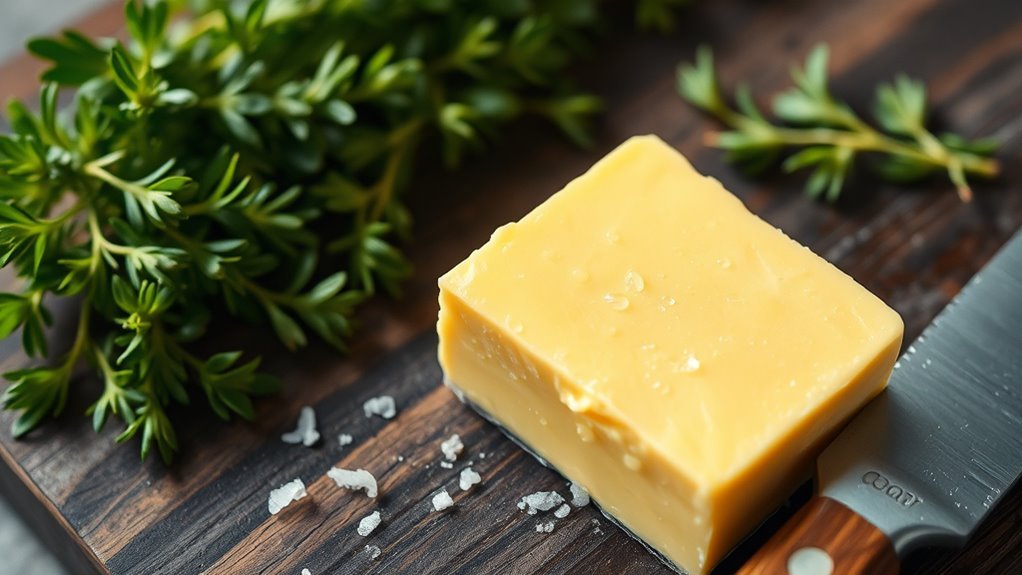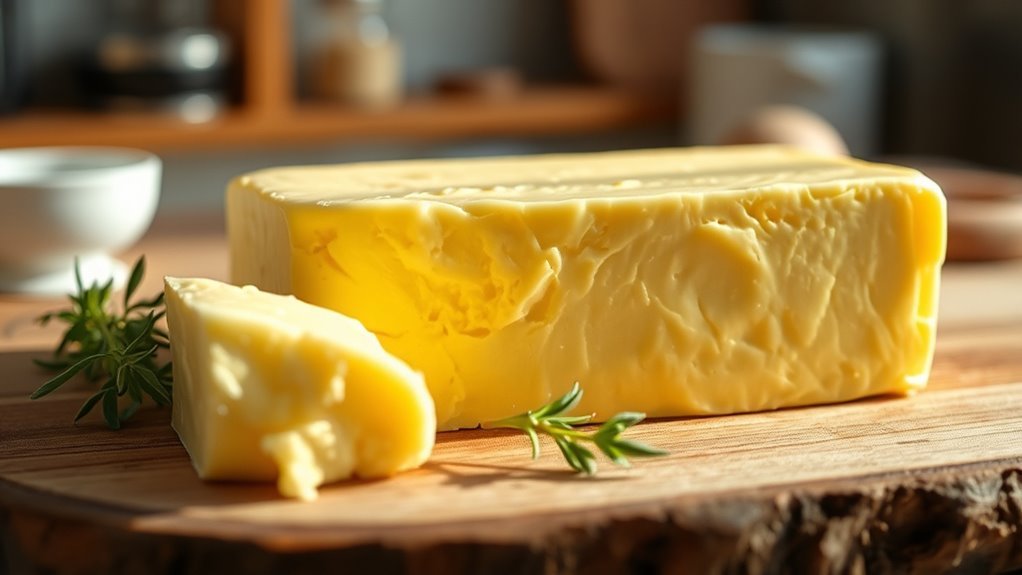Yes, butter is keto-friendly! With around 81g of fat and only 0.1g of carbohydrates per 100g, it aligns perfectly with low-carb diets. This high-fat content can help keep you satisfied while staying within your macro goals. Additionally, butter provides essential fat-soluble vitamins. Whether you prefer grass-fed or conventional, it can enhance your meals. To explore more about how butter fits into the keto lifestyle and its benefits, consider the following insights.
Understanding the Ketogenic Diet

When you’re exploring the ketogenic diet, it’s vital to understand its core principles. At its heart, the ketogenic diet focuses on drastically reducing carbohydrate intake while increasing fat consumption. These ketogenic principles encourage your body to enter a state of ketosis, where it burns fat for energy instead of glucose. This shift can lead to enhanced fat loss and improved energy levels. However, the diet does come with dietary restrictions; you’ll need to limit high-carb foods like grains, sugars, and certain fruits. Embracing these changes offers freedom from conventional eating patterns, allowing you to experience potential health benefits. Just remember, it’s always wise to consult a healthcare professional before making significant dietary changes to guarantee it aligns with your personal health needs.
Nutritional Profile of Butter

When considering butter in your diet, it’s essential to look at its macronutrient composition and the vitamins and minerals it provides. Butter primarily consists of fats, which can be beneficial for those following a ketogenic lifestyle. Additionally, it contains fat-soluble vitamins like A, D, E, and K, contributing to its overall nutritional value.
Macronutrient Composition
Butter is a rich source of fats, making it a staple in many keto diets. With its high-fat content, it provides essential energy while keeping carb intake low. If you’re considering butter substitutes or keto alternatives, it’s vital to understand its macronutrient composition.
| Macronutrient | Amount per 100g | Percentage of Total Calories |
|---|---|---|
| Fat | 81g | 100% |
| Protein | 1g | 1% |
| Carbohydrates | 0.1g | <1% |
This table illustrates that butter is mainly fat, which aligns perfectly with keto principles. When looking for substitutes, options like ghee or coconut oil can replicate the high-fat benefits, keeping you in ketosis while adding variety to your meals.
Vitamins and Minerals
High in fat, butter also contains a variety of vitamins and minerals that contribute to its nutritional profile. You’ll find butter nutrients like vitamins A, D, E, and K, which are essential for various bodily functions. These fat-soluble vitamins can enhance vitamin absorption, meaning your body can utilize them more effectively when consumed with fats. For instance, vitamin A supports vision and immune function, while vitamin D is vital for bone health. Additionally, butter contains small amounts of calcium and phosphorus, which are important for maintaining strong bones. However, moderation is key; while these nutrients are beneficial, consuming excessive butter may lead to imbalances in your diet. Enjoy butter mindfully to reap its nutritional benefits while adhering to your dietary goals.
Types of Butter: Grass-Fed vs. Conventional

When choosing between grass-fed and conventional butter, it’s important to contemplate their nutritional differences and how they might affect your keto diet. Grass-fed butter is often richer in omega-3 fatty acids and certain vitamins, which can influence both flavor and cooking applications. Understanding these distinctions can help you make a more informed choice that aligns with your health goals.
Nutritional Differences Explained
Although both grass-fed and conventional butter provide similar basic nutrients, their composition can differ markedly, impacting your overall health and dietary choices. Grass-fed butter typically contains higher levels of omega-3 fatty acids and vitamin K2, which can be beneficial for heart health. Conversely, conventional butter may have more saturated fats and fewer nutrients due to the cows’ diets. If you have dairy sensitivity, it’s essential to choose higher-quality butter or explore butter alternatives, like ghee or plant-based spreads, which can offer similar flavors without the lactose. Understanding these differences empowers you to make informed dietary decisions aligned with your health goals, whether you prioritize nutritional content or choose to explore various butter options.
Flavor and Cooking Uses
Two distinct types of butter—grass-fed and conventional—offer unique flavors and cooking uses that can enhance your culinary experience. Grass-fed butter tends to have a richer, more complex flavor profile due to the cows’ diet of fresh grass, which can elevate your cooking techniques. You might find it particularly delightful in sauces or baked goods, adding depth to your dishes. On the other hand, conventional butter is often creamier and more neutral, making it versatile for everyday cooking. Whether you’re sautéing vegetables or making a classic pastry, both butter flavors can play a significant role. Experimenting with these different types of butter can truly transform your meals and inspire creativity in your kitchen.
Health Benefits Comparison
While both grass-fed and conventional butter offer distinct flavors, their health benefits can vary considerably. Grass-fed butter tends to have higher levels of omega-3 fatty acids and vitamins A and K2, which may support heart health and enhance immune function. If you’re mindful of health impacts, choosing grass-fed butter could align better with your dietary evaluations. Conversely, conventional butter is often less expensive and more accessible, but it may not provide the same nutritional benefits. Ultimately, the choice between the two should reflect your personal health goals and budget. Embracing either option can fit within a balanced diet, so it’s important to reflect on what aligns best with your lifestyle and nutritional needs.
The Role of Fats in a Keto Diet
Fats play an essential role in a ketogenic diet, as they serve as the primary source of energy when carbohydrate intake is greatly reduced. Understanding the different fat types and their dietary sources can help you thrive on this low-carb lifestyle.
| Fat Type | Dietary Sources |
|---|---|
| Saturated Fats | Butter, coconut oil |
| Monounsaturated | Olive oil, avocados |
| Polyunsaturated | Fatty fish, nuts |
| Trans Fats | Processed foods (avoid) |
| Omega-3 & Omega-6 | Flaxseeds, chia seeds |
Incorporating healthy fats into your meals can provide you with sustained energy, promote satiety, and support overall health. Embrace the freedom to explore various fat sources while enjoying the benefits of a ketogenic diet.
How Butter Fits Into Your Daily Macros
When you’re following a ketogenic diet, understanding how to incorporate butter into your daily macros can enhance your meal planning and overall success. Butter is a fantastic source of healthy fats, contributing to your daily calorie intake while keeping you in ketosis. Typically, a daily serving of butter can range from one to three tablespoons, depending on your overall fat goals. Keep in mind that if you’re looking for butter substitutes, options like coconut oil or avocado oil can also fit well within your macros. Just be sure to track your intake to maintain that delicate balance of fats, proteins, and carbs. Finding the right amount of butter can free you to enjoy flavorful meals while sticking to your keto lifestyle.
Cooking With Butter on Keto
Cooking with butter on a ketogenic diet can elevate the flavor of your meals while providing a rich source of healthy fats. It’s versatile, but if you’re looking for alternatives, consider options like ghee or coconut oil. These butter alternatives also contribute healthy fats and can complement various cooking techniques.
Here’s a quick comparison of butter and its alternatives:
| Cooking Fat | Smoke Point | Flavor Profile | Keto-Friendly |
|---|---|---|---|
| Butter | 350°F | Rich, creamy | Yes |
| Ghee | 485°F | Nutty | Yes |
| Coconut Oil | 350°F | Sweet, tropical | Yes |
| Olive Oil | 375°F | Fruity | Yes |
Experimenting with these options can enhance your keto cooking experience while keeping it delicious and satisfying.
Potential Health Benefits of Butter
While many people have debated the health implications of butter, it offers several potential benefits that align well with a ketogenic lifestyle. For starters, butter’s healthy fats can support heart health by promoting good cholesterol levels. It also aids in weight management by enhancing the satiety factor, helping you feel full longer. Butter can provide an energy boost, making it a great addition to your meals. Its fat content assists in nutrient absorption, essential for digestive health. Additionally, the anti-inflammatory properties may contribute to inflammation reduction. Beyond that, butter supports skin health and brain function, thanks to its rich vitamins. Embracing butter can be a delicious way to enjoy these benefits while adhering to your keto journey.
Common Misconceptions About Butter
Many people mistakenly view butter as an unhealthy food choice, primarily due to its saturated fat content. This perception leads to various butter myths that overshadow its benefits. In reality, many studies suggest that moderate butter consumption can fit into a healthy diet. Here are some common misconceptions:
| Butter Myths | Butter Facts |
|---|---|
| Butter raises cholesterol levels. | Moderate intake may not affect cholesterol negatively. |
| It contributes to weight gain. | It’s calorie-dense but can help with satiety. |
| All fats are bad for health. | Healthy fats, like those in butter, are essential. |
Understanding these butter facts can liberate you from outdated beliefs, allowing you to enjoy this rich source of flavor responsibly.
Creative Ways to Incorporate Butter Into Meals
Incorporating butter into your meals can elevate both flavor and nutrition, especially when you’re following a keto diet. Consider making rich butter sauces to drizzle over grilled meats or veggies, enhancing taste without carbs. You can whip up butter spreads flavored with herbs to liven up your bread alternatives. For a sweet touch, indulge in butter desserts like keto-friendly brownies or cookies. Use butter toppings on your favorite dishes, adding a creamy finish. Don’t forget butter dips for fresh veggies or meats, which can be both satisfying and nutritious. Experiment with butter marinades for marinating proteins, and create butter dressings for salads. Finally, blend butter into your smoothies for a creamy, satisfying boost. Enjoy the freedom to get creative!


